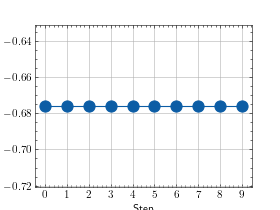InfoLM¶
Module Interface¶
- class torchmetrics.text.infolm.InfoLM(model_name_or_path='bert-base-uncased', temperature=0.25, information_measure='kl_divergence', idf=True, alpha=None, beta=None, device=None, max_length=None, batch_size=64, num_threads=0, verbose=True, return_sentence_level_score=False, **kwargs)[source]¶
Calculate InfoLM.
InfoLM measures a distance/divergence between predicted and reference sentence discrete distribution using one of the following information measures:
L1 distance
L2 distance
L-infinity distance
InfoLM is a family of untrained embedding-based metrics which addresses some famous flaws of standard string-based metrics thanks to the usage of pre-trained masked language models. This family of metrics is mainly designed for summarization and data-to-text tasks.
The implementation of this metric is fully based HuggingFace
transformers’ package.As input to
forwardandupdatethe metric accepts the following input:preds(Sequence): An iterable of hypothesis corpustarget(Sequence): An iterable of reference corpus
As output of
forwardandcomputethe metric returns the following output:infolm(Tensor): If return_sentence_level_score=True return a tuple with a tensor with the corpus-level InfoLM score and a list of sentence-level InfoLM scores, else return a corpus-level InfoLM score
- Parameters:
model_name_or_path¶ (
Union[str,PathLike]) – A name or a model path used to loadtransformerspretrained model. By default the “bert-base-uncased” model is used.temperature¶ (
float) – A temperature for calibrating language modelling. For more information, please reference InfoLM paper.information_measure¶ (
Literal['kl_divergence','alpha_divergence','beta_divergence','ab_divergence','renyi_divergence','l1_distance','l2_distance','l_infinity_distance','fisher_rao_distance']) – A name of information measure to be used. Please use one of: [‘kl_divergence’, ‘alpha_divergence’, ‘beta_divergence’, ‘ab_divergence’, ‘renyi_divergence’, ‘l1_distance’, ‘l2_distance’, ‘l_infinity_distance’, ‘fisher_rao_distance’]idf¶ (
bool) – An indication of whether normalization using inverse document frequencies should be used.alpha¶ (
Optional[float]) – Alpha parameter of the divergence used for alpha, AB and Rényi divergence measures.beta¶ (
Optional[float]) – Beta parameter of the divergence used for beta and AB divergence measures.device¶ (
Union[device,str,None]) – A device to be used for calculation.max_length¶ (
Optional[int]) – A maximum length of input sequences. Sequences longer thanmax_lengthare to be trimmed.num_threads¶ (
int) – A number of threads to use for a dataloader.verbose¶ (
bool) – An indication of whether a progress bar to be displayed during the embeddings calculation.return_sentence_level_score¶ (
bool) – An indication whether a sentence-level InfoLM score to be returned.
Example
>>> from torchmetrics.text.infolm import InfoLM >>> preds = ['he read the book because he was interested in world history'] >>> target = ['he was interested in world history because he read the book'] >>> infolm = InfoLM('google/bert_uncased_L-2_H-128_A-2', idf=False) >>> infolm(preds, target) tensor(-0.1784)
- plot(val=None, ax=None)[source]¶
Plot a single or multiple values from the metric.
- Parameters:
val¶ (
Union[Tensor,Sequence[Tensor],None]) – Either a single result from calling metric.forward or metric.compute or a list of these results. If no value is provided, will automatically call metric.compute and plot that result.ax¶ (
Optional[Axes]) – An matplotlib axis object. If provided will add plot to that axis
- Return type:
- Returns:
Figure and Axes object
- Raises:
ModuleNotFoundError – If matplotlib is not installed
>>> # Example plotting a single value >>> from torchmetrics.text.infolm import InfoLM >>> metric = InfoLM('google/bert_uncased_L-2_H-128_A-2', idf=False) >>> preds = ['he read the book because he was interested in world history'] >>> target = ['he was interested in world history because he read the book'] >>> metric.update(preds, target) >>> fig_, ax_ = metric.plot()

>>> # Example plotting multiple values >>> from torchmetrics.text.infolm import InfoLM >>> metric = InfoLM('google/bert_uncased_L-2_H-128_A-2', idf=False) >>> preds = ["this is the prediction", "there is an other sample"] >>> target = ["this is the reference", "there is another one"] >>> values = [ ] >>> for _ in range(10): ... values.append(metric(preds, target)) >>> fig_, ax_ = metric.plot(values)

Functional Interface¶
- torchmetrics.functional.text.infolm.infolm(preds, target, model_name_or_path='bert-base-uncased', temperature=0.25, information_measure='kl_divergence', idf=True, alpha=None, beta=None, device=None, max_length=None, batch_size=64, num_threads=0, verbose=True, return_sentence_level_score=False)[source]¶
Calculate InfoLM [1].
InfoML corresponds to distance/divergence between predicted and reference sentence discrete distribution using one of the following information measures:
L1 distance
L2 distance
L-infinity distance
InfoLM is a family of untrained embedding-based metrics which addresses some famous flaws of standard string-based metrics thanks to the usage of pre-trained masked language models. This family of metrics is mainly designed for summarization and data-to-text tasks.
If you want to use IDF scaling over the whole dataset, please use the class metric.
The implementation of this metric is fully based HuggingFace transformers’ package.
- Parameters:
preds¶ (
Union[str,Sequence[str]]) – An iterable of hypothesis corpus.target¶ (
Union[str,Sequence[str]]) – An iterable of reference corpus.model_name_or_path¶ (
Union[str,PathLike]) – A name or a model path used to load transformers pretrained model.temperature¶ (
float) – A temperature for calibrating language modelling. For more information, please reference InfoLM paper.information_measure¶ (
Literal['kl_divergence','alpha_divergence','beta_divergence','ab_divergence','renyi_divergence','l1_distance','l2_distance','l_infinity_distance','fisher_rao_distance']) – A name of information measure to be used. Please use one of: [‘kl_divergence’, ‘alpha_divergence’, ‘beta_divergence’, ‘ab_divergence’, ‘renyi_divergence’, ‘l1_distance’, ‘l2_distance’, ‘l_infinity_distance’, ‘fisher_rao_distance’]idf¶ (
bool) – An indication of whether normalization using inverse document frequencies should be used.alpha¶ (
Optional[float]) – Alpha parameter of the divergence used for alpha, AB and Rényi divergence measures.beta¶ (
Optional[float]) – Beta parameter of the divergence used for beta and AB divergence measures.device¶ (
Union[device,str,None]) – A device to be used for calculation.max_length¶ (
Optional[int]) – A maximum length of input sequences. Sequences longer than max_length are to be trimmed.num_threads¶ (
int) – A number of threads to use for a dataloader.verbose¶ (
bool) – An indication of whether a progress bar to be displayed during the embeddings calculation.return_sentence_level_score¶ (
bool) – An indication whether a sentence-level InfoLM score to be returned.
- Return type:
- Returns:
A corpus-level InfoLM score. (Optionally) A list of sentence-level InfoLM scores if return_sentence_level_score=True.
Example
>>> from torchmetrics.functional.text.infolm import infolm >>> preds = ['he read the book because he was interested in world history'] >>> target = ['he was interested in world history because he read the book'] >>> infolm(preds, target, model_name_or_path='google/bert_uncased_L-2_H-128_A-2', idf=False) tensor(-0.1784)
References
[1] InfoLM: A New Metric to Evaluate Summarization & Data2Text Generation by Pierre Colombo, Chloé Clavel and Pablo Piantanida InfoLM
